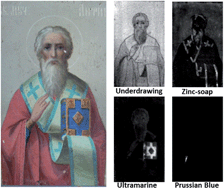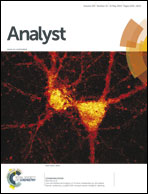Macroscopic Fourier transform infrared scanning in reflection mode (MA-rFTIR), a new tool for chemical imaging of cultural heritage artefacts in the mid-infrared range
Abstract
In this paper we demonstrate that by means of scanning reflection FTIR spectroscopy, it is possible to record highly specific distribution maps of organic and inorganic compounds from flat, macroscopic objects with cultural heritage value in a non-invasive manner. Our previous work involved the recording of macroscopic distributions of chemical elements or crystal phases from painted works of art based on respectively macroscopic X-ray fluorescence or X-ray powder diffraction analysis. The use of infrared radiation instead of X-rays has the advantage that more specific information about the nature and distribution of the chemical compounds present can be gathered. This higher imaging specificity represents a clear advantage for the characterization of painting and artist materials. It allows the distribution of metallo-organic compounds to be visualized and permits distinguishing between pigmented materials containing the same key metal. The prototype instrument allows the recording of hyperspectral datacubes by scanning the surface of the artefact in a contactless and sequential single-point measuring mode, while recording the spectrum of reflected infrared radiation. After the acquisition, spectral line intensities of individual bands and chemical distribution maps can be extracted from the datacube to identify the compounds present and/or to highlight their spatial distribution. Not only is information gained on the surface of the investigated artefacts, but also images of overpainted paint layers and, if present, the underdrawing may be revealed in this manner. A current major limitation is the long scanning times required to record these maps.


 Please wait while we load your content...
Please wait while we load your content...